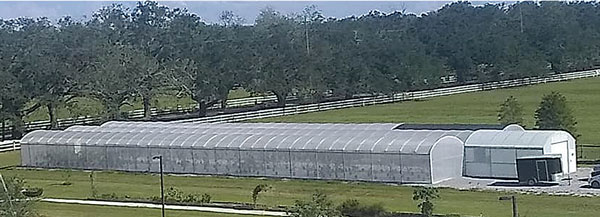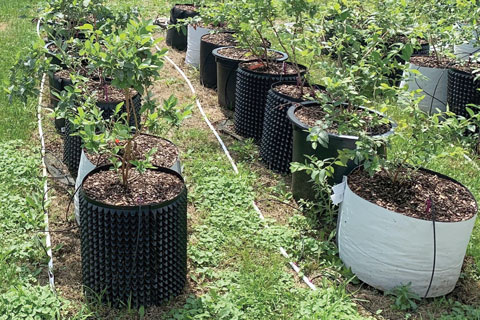3/1/2022
Soilless Substrate Science
Jeb S. Fields, Jim Owen, James Altland, Brian Jackson & Alexa Lamm

Soil is at the root of all agriculture, historically dictating where and how crops are grown. However, many specialty crops have transitioned to relatively small closed systems we commonly refer to as containers. These crops have need for easy transportation, environmental control and more precision with water, fertilizer and agrichemicals.
Pictured: The LSU AgCenter is working to optimize substrates for container-grown citrus at the Docville Farm’s Fruit Under Screened Enclosures (FUSE) facility.
With diminishing availability of fumigants, increasing pest pressure and the need for flexibility, a new wave of traditionally soil-based agriculture sectors have begun the transition into soilless systems. Small fruit—including blueberries, brambles and strawberries, as well as tree fruits—are beginning to explore the possibilities of soilless culture.
Soilless substrates are often comprised of organic materials and industrial byproducts that have been optimized for growing systems. We classify soilless substrates following classical standards designed to meet growing specifications for traditional container-produced crops (i.e., ornamentals). While these specifications will often achieve desired outcomes, they’ve been developed for specific crops and new crops will have new requirements.
Our colleagues at Wageningen University (the Netherlands) recently predicted a four-fold increase in the volume of soilless substrate needed on the global market by 2050. This increase is due to expanding markets, emerging novel growing systems and increasing populations. Thus, we’re presented with an opportunity and challenge to reimagine traditional soilless systems to support growers and reduce demand of resources as they transition and expand the use of soilless production methods into the future.
With this in mind, a multi-disciplinary team of academics and scientists was assembled to assess the current and future state of soilless substrate research in North America through support from the USDA Specialty Crops Research Initiative. Through this project, we developed a protocol to assess grower and supplier needs across crop types to shed light on the future of our industry, and most importantly, how researchers like ourselves can support growers. As such, the ability to utilize the data from this assessment and survey is being used to better address future substrate demands and ensure the future success of North American specialty crops through creative innovative solutions. This article will be the first in a three-part series focusing on the key findings of our recent soilless substrate needs assessment.
What do growers need?
Our initial needs survey received over 300 responses from across North America. Growers responding to the survey represented a wide variety of horticulture sectors, including producers of vegetables, small fruit, ornamentals, tree fruit and medicinal crops.
The survey responses were then utilized to inform small grower focus groups and one-on-one interviews with a representative sample of commercial soilless substrate suppliers, blenders and distributors to ensure a holistic understanding of the current and future needs surrounding the use of soilless substrate in horticulture.
 Pictured: Research underway at the USDA-ARS Application Technology Research Unit in Wooster, Ohio, evaluating substrate and container type on blueberry production.
Pictured: Research underway at the USDA-ARS Application Technology Research Unit in Wooster, Ohio, evaluating substrate and container type on blueberry production.
The initial understanding is that non-traditional soilless producers are becoming increasingly interested in transitioning to soilless culture. There’s been a recent increase in fruit crops shifting to soilless production, where research across the globe is beginning to identify benefits associated with quicker yield, more efficient resource management, production on land that’s not arable, increased crop density, lower agrichemical requirements and more. This movement started gaining popularity in small fruit, but is quickly extending to other horticultural crops, especially with beginning growers who tend to start container production of crops citing increased sustainability as the primary reason.
Our research found that growers focus on crop quality, pest management and reduction in crop losses as the primary considerations for adopting containerized production. Crop quality was the most important factor for growers in our survey, as well as consumer demand for improved crop quality.
Crop uniformity and how it can be improved or maintained through soilless culture also was prominent. In many cases, container production allows for incredible crop uniformity for ornamental crops. However, it’s important to understand how fruit yield will be affected through container production on a large scale.
This brings us to the prominent need that growers identified: There must be research to support and assist growers with implementation of soilless production systems, especially those who have long-established in-ground production practices. Water and fertilizer were prominent discussion points, with current soilless growers understanding how critical precision water and nutrient application is to ensure profitable crop production. There are drastic differences in irrigation and fertilizer when growing a crop in a container vs. in the ground. These differences are well documented for current soilless culture crops such as ornamentals and vegetables, but similarly to uniformity, need to be further explored in many fruit cropping systems.
Value-added substrates also were discussed by growers. As researchers, we often expend effort to developing cheaper and more implementable substrate options. However, many experienced growers were keen to trying more costly options if there were production benefits, such as resource efficiency, crop quality and uniformity, pest control, and above all, quicker or increased yield. This idea can open doors for enhanced designer substrate development, specifically with targeted outcomes in mind.
Cost of implementation was one of the primary barriers to adoption for growers considering transition to soilless systems. There are significant up-front capital costs associated with shifting to soilless culture. As such, it was noted that growers interested in exploring these opportunities may elect to seek a gradual transition into soilless culture. A gradual transition may reduce the feeling of commitment and allow growers to address problematic areas in a manageable setting, or better yet, allow extension personnel to aid in the transition. This approach also may mitigate risk associated with the “learning curve” around water and fertility management, in addition to system-wide adjustments to everything from logistical matters to pest management.
Moving the industry forward
Substrate suppliers provided a very insightful perspective into the future of soilless substrates. The first and most impactful idea was the concept of “designer” substrates. Suppliers are interested in utilizing regional materials and engineering application-specific substrates to assist growers with their explicit needs. This bodes well, as many experienced growers also mentioned the interest in designer substrates.
From all phases and audiences in this research, the need to better understand the basics of substrate science and how to design a substrate to suit a grower’s specific needs was a prominent message for the future.
Another very interesting concept was the reliance on public research sectors. While many suppliers conduct research and advance substrate science in-house, trade shows and research conferences were acknowledged as essential for sharing ideas, accelerating research objectives and promoting key ideas. The development of designer substrates will undoubtedly require collaborative efforts between growers, substrate manufacturers and university researchers working together to forward the industry.
Substrate research tends to focus on production of relatively short-term crops. As we shift into new cropping sectors, such as small and tree fruits, new frontiers in substrate science will have to be addressed to ease transition into this inevitable progression of the horticultural industry. Development of long-term substrates will be a critical research effort. Research is already underway to identify a plausible way to grow a plant in a single container for over 10 years. The idea behind this is impressive, as to maintain a viable and productive crop for that long will require reimagining of the substrate system to ensure that the plant can continue to grow, and access necessary water and mineral nutrients.
Ultimately, uniformity within and among substrates, from source to user, was discussed as a critical factor by both growers and suppliers. The ability to ensure quality control and that each successive delivery of substrate performs the same is a major factor in the ability to grow the industry. In the time since the finalizing of this research project, challenges associated with access to materials have arisen. Access and associated costs of media and other inputs have become an issue for many. This can have severe consequences for growers, especially those considering shifting into new soilless production practices. The ability to regularly secure consistent substrate, fertilizer, containers, irrigation materials, etc. is critical for long-term continued success.
Many specialty crop growers either have or will soon face the choice of incorporating soilless production into their operations. Growers will continue to rely upon public research programs to facilitate the transition and expansion of soilless culture. Beyond the growers, substrate suppliers are working with researchers to develop new and improved materials, as well as new management systems to support growers in an ever-changing world.
In the next two segments, we’ll delve deeper into opportunities and provide some support for overcoming some challenges. Finally, we’ll turn an eye to the future and where we see the soilless substrate community heading. GT
Jeb Fields is the Assistant Research Coordinator of the Hammond Research Station and Director of the Hammond Trial Gardens at the Louisiana State University Agricultural Center. Jeb can be reached at JFields@agcenter.lsu.edu. Jim Owen is a Research Horticulturist and James Altland is a Research Leader and Horticulturist, both at the USDA-ARS in Wooster, Ohio. Brian Jackson is a Professor of Substrate Science and Director of the Horticultural Substrates Laboratory at North Carolina State University, and Alexa Lamm is an Associate Professor of Science Communication at the University of Georgia.